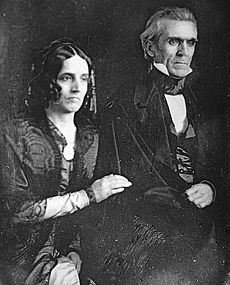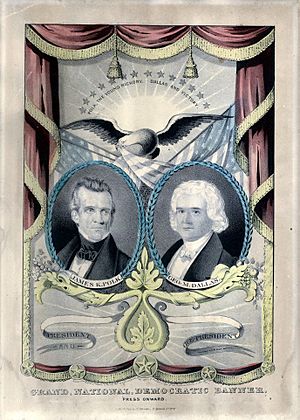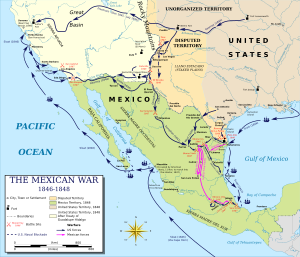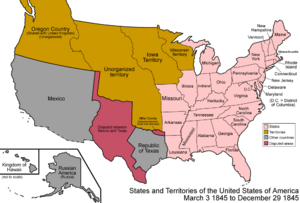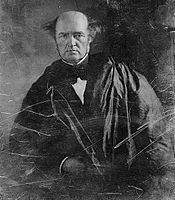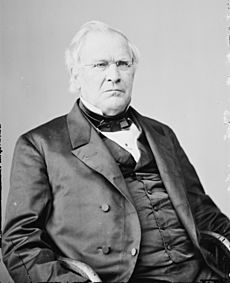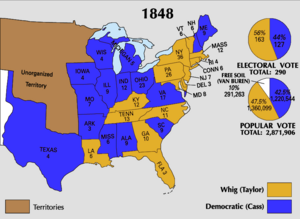James K. Polk facts for kids
Quick facts for kids
James K. Polk
|
|
|---|---|

Portrait by Mathew Brady, c. 1849
|
|
| 11th President of the United States | |
| In office March 4, 1845 – March 4, 1849 |
|
| Vice President | George M. Dallas |
| Preceded by | John Tyler |
| Succeeded by | Zachary Taylor |
| 9th Governor of Tennessee | |
| In office October 14, 1839 – October 15, 1841 |
|
| Preceded by | Newton Cannon |
| Succeeded by | James C. Jones |
| 13th Speaker of the United States House of Representatives | |
| In office December 7, 1835 – March 3, 1839 |
|
| Preceded by | John Bell |
| Succeeded by | Robert M. T. Hunter |
| Member of the U.S. House of Representatives from Tennessee |
|
| In office March 4, 1825 – March 3, 1839 |
|
| Preceded by | John Alexander Cocke |
| Succeeded by | Harvey Magee Watterson |
| Constituency | 6th district (1833–1839) 9th district (1825–1833) |
| Personal details | |
| Born |
James Knox Polk
November 2, 1795 Pineville, North Carolina, U.S. |
| Died | June 15, 1849 (aged 53) Nashville, Tennessee, U.S. |
| Resting place | Tennessee State Capitol |
| Political party | Democratic |
| Spouse | |
| Parents |
|
| Education | University of North Carolina at Chapel Hill (AB) |
| Occupation |
|
| Signature | |
| Nicknames |
|
|
Other offices
1833–1835: Chair of the House Ways and Means Committee
|
|
James Knox Polk (born November 2, 1795 – died June 15, 1849) was the 11th president of the United States. He served as president from 1845 to 1849. Before becoming president, he was the 13th Speaker of the House (1835–1839) and the ninth governor of Tennessee (1839–1841).
Polk was a close follower of Andrew Jackson and a member of the Democratic Party. He is best known for greatly expanding the United States' territory. During his time as president, the U.S. grew significantly. This happened through the annexation of Texas, gaining the Oregon Territory, and the Mexican Cession. The Mexican Cession was land won after the Mexican–American War.
Polk started as a successful lawyer in Tennessee. He was elected to the state legislature in 1823. Then, in 1825, he joined the United States House of Representatives. He strongly supported Andrew Jackson. Polk became the Speaker of the House in 1835. He is the only person to have been both Speaker and U.S. president. He later ran for governor of Tennessee, winning in 1839 but losing in 1841 and 1843.
In the 1844 United States presidential election, Polk was a surprise candidate. He was not expected to win the Democratic nomination. However, he became the party's choice for president. He defeated Henry Clay of the Whig Party in the election.
As president, Polk settled a land dispute with Great Britain over the Oregon Country. Most of this territory was divided along the 49th parallel. He also led the U.S. to victory in the Mexican–American War. This war resulted in Mexico giving up a large area of land in the Southwestern United States. Polk also lowered tariff rates with the Walker tariff of 1846. He also brought back the Independent Treasury system.
Polk had promised to serve only one term. He kept his promise and left office in 1849. He returned to Tennessee and died three months later. Today, historians often rank Polk as a successful president. This is because he achieved all his major goals during his single term. However, he is also criticized for leading the country into war with Mexico. This war made the divisions between free and slave states much worse, leading to the American Civil War.
Contents
Early Life and Education
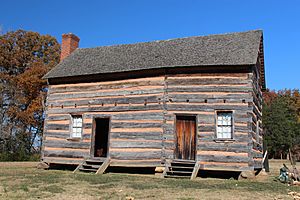
James Knox Polk was born on November 2, 1795. He was born in a log cabin in Pineville, North Carolina. He was the first of ten children in a farming family. His mother, Jane, named him after her father, James Knox. His father, Samuel Polk, was a farmer and surveyor. The Polk family had come to America in the late 1600s.
The Knox and Polk families were Presbyterian. James's mother was very religious. She taught him to be disciplined and hardworking. In 1806, Samuel Polk and his family moved to the Duck River area in Maury County, Tennessee. The Polk family became important in local politics. Samuel became a judge. Famous people like Andrew Jackson visited their home. James learned a lot about politics from these discussions.
As a child, Polk was often sick. He had painful urinary stones. A doctor named Ephraim McDowell operated on him. After the surgery, James recovered quickly and became stronger. His father offered him a job in his business. But James wanted to go to school. He enrolled in a Presbyterian academy in 1813. He was a promising student.
In 1816, Polk started at the University of North Carolina at Chapel Hill. He joined the Dialectic Society, where he practiced debating. He became its president and learned how to give speeches. Polk graduated with honors in May 1818.
After college, Polk studied law in Nashville, Tennessee. His teacher was the famous lawyer Felix Grundy. In 1819, Polk was elected clerk of the Tennessee Senate. He was re-elected in 1821. In 1820, he became a lawyer. He opened his own office and was very successful. His law practice helped him pay for his political career.
Early Political Career
Starting in Tennessee Politics
By 1822, Polk decided to run for the Tennessee House of Representatives. The election was in August 1823. He had plenty of time to campaign. He was already involved in his community as a Mason. He also became a captain in the Tennessee militia. People liked Polk's speeches. This earned him the nickname "Napoleon of the Stump."
In 1824, Polk married Sarah Childress. She was very well-educated for her time. Sarah came from an important family in Tennessee. During James's political career, Sarah helped him a lot. She helped with his speeches and gave him advice. She also played an active role in his campaigns. Sarah Polk's charm and intelligence helped make up for James's serious personality.
Polk's first political mentor was Felix Grundy. But Polk soon started to support Andrew Jackson. Jackson was a military hero after the Battle of New Orleans in 1815. Jackson was a family friend to both the Polks and the Childresses. James Polk quickly supported Jackson's plan to become president in 1824. When the Tennessee Legislature had trouble choosing a U.S. senator in 1823, Jackson's name was suggested. Polk voted for Jackson, who won. This helped Jackson's chances for president. This was the start of a strong alliance between Polk and Jackson. Polk was often called "Young Hickory," after Jackson's nickname, "Old Hickory."
In the 1824 election, Jackson won the most votes. But he did not win enough votes in the Electoral College. So, the election was decided by the U.S. House of Representatives. The House chose John Quincy Adams. Polk and other Jackson supporters believed that Henry Clay had made a "Corrupt Bargain" with Adams. They thought Clay helped Adams win in exchange for a job as Secretary of State.
In August 1824, Polk announced he would run for the U.S. House of Representatives. He campaigned very hard. His opponents said he was too young at 29. But he won the election and took his seat in Congress.
Supporting Andrew Jackson
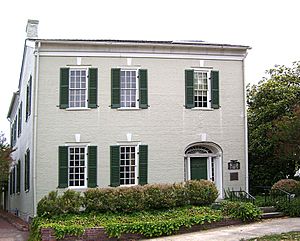
When Polk arrived in Washington, D.C. in December 1825, he shared a house with other Tennessee representatives. He gave his first big speech in March 1826. He said that the president should be elected by popular vote. Polk was very critical of the Adams administration. He often voted against its policies. Sarah Polk joined him in Washington in December 1826. She helped him with his letters and listened to his speeches.
Polk was re-elected in 1827. He continued to oppose the Adams government. He stayed in close contact with Jackson. When Jackson ran for president in 1828, Polk was an important advisor. After Jackson won, Polk became one of his most loyal supporters. Polk helped Jackson oppose federal funding for "internal improvements" like roads. He was happy when Jackson blocked a bill to fund a road in Kentucky.
Polk was Jackson's main supporter in the "Bank War." This was about Jackson's opposition to the Second Bank of the United States. This bank controlled much of the money and credit in the U.S. Jackson and many Westerners thought it was a monopoly that favored Easterners. Polk, as a member of the House Ways and Means Committee, investigated the bank. He wrote a strong report against it. Congress passed a bill to renew the bank's charter, but Jackson vetoed it. Congress could not get enough votes to override the veto. Jackson's action was popular with the public, and he won re-election easily in 1832.
Like most Southerners, Polk wanted low taxes on imported goods (tariffs). He first agreed with John C. Calhoun's opposition to the high Tariff of Abominations. This led to the Nullification Crisis of 1832–1833. But Polk sided with Jackson when Calhoun suggested states could leave the Union. Polk supported Jackson's efforts to keep federal authority. He was against states leaving the Union and supported the Force Bill against South Carolina. This issue was settled when Congress passed a compromise tariff.
Leading the House of Representatives
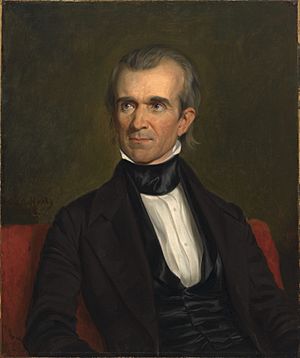
In December 1833, Polk was elected to his fifth term in Congress. With Jackson's support, he became the chairman of the House Ways and Means Committee. This was a very powerful position. In this role, Polk supported Jackson's decision to remove federal money from the Second Bank. Polk's committee wrote reports supporting Jackson's actions against the bank. He also helped pass laws that allowed the government to sell its shares in the bank.
In June 1834, the Speaker of the House, Andrew Stevenson, resigned. With Jackson's support, Polk ran for Speaker. After many votes, he lost to John Bell. But Jackson worked hard to get Polk elected Speaker at the start of the next Congress in December 1835. This time, Polk defeated Bell and became Speaker.
As Speaker, Polk worked to support Jackson's policies and later those of Martin Van Buren. Polk made sure that committees were led by Democrats. He tried to act fairly as Speaker, but he still pushed his party's agenda. The two main issues during Polk's time as Speaker were slavery and the economy after the Panic of 1837. Polk strictly enforced the "gag rule." This rule meant the House would not discuss petitions about slavery. This angered John Quincy Adams, who was then a congressman and against slavery.
The economic problems caused Democrats to lose seats in Congress. When Polk ran for Speaker again in December 1837, he won by only 13 votes. He knew he might lose in 1839. Polk wanted to become president someday. But no Speaker of the House had ever become president before. After seven terms in the House, Polk decided not to run again. Instead, he chose to run for Governor of Tennessee in 1839.
Becoming Governor of Tennessee
In 1835, the Democrats had lost the governorship of Tennessee for the first time. Polk decided to go home and help his party. Tennessee had become very supportive of the Whig Party. As the leader of the state Democratic Party, Polk ran his first statewide campaign. He ran against the Whig governor, Newton Cannon.
Polk focused on national issues during his campaign. Cannon talked about state issues. Polk debated Cannon across the state. Polk won the election on August 1, 1839. He defeated Cannon by about 2,700 votes. The Democrats also won back control of the state legislature and some congressional seats.
The governor of Tennessee had limited power. There was no veto power, and the state government was small. But Polk saw the office as a way to reach his national goals. He hoped to be chosen as Van Buren's vice president in the 1840 Democratic National Convention. Polk hoped to replace Vice President Richard Mentor Johnson. However, the convention decided not to choose a vice president. Polk later withdrew his name.
The Whig presidential candidate, General William Henry Harrison, ran a very popular campaign. He easily won the national vote and in Tennessee. Polk campaigned for Van Buren but was embarrassed by the loss. Jackson was very upset about a Whig president. In the 1840 election, Polk received one vote for vice president from an faithless elector. Harrison died after only a month in office in 1841. This made Vice President John Tyler president. Tyler soon disagreed with the Whigs.
Polk had three main goals as governor:
- Regulate state banks.
- Improve state internal transportation.
- Improve education.
All these plans failed to pass the legislature. His only big success was getting two Whig U.S. senators from Tennessee replaced by Democrats. Polk's time as governor was difficult because of the ongoing economic crisis.
In 1841, the Whigs ran James C. Jones against Polk. Jones was a new legislator. He was known for his lighthearted style in debates, which was very effective against the serious Polk. The two debated across Tennessee. Jones's ideas about sharing federal money with states and having a national bank were popular. Polk lost to Jones by 3,000 votes. This was his first election loss.
Polk returned to his law practice in Columbia. He prepared for a rematch against Jones in 1843. But he lost again, this time by 3,833 votes. After two statewide losses, Polk's political future seemed uncertain.
The Election of 1844
Becoming the Democratic Candidate
Even after his losses, Polk was determined to become the next vice president. He saw it as a way to become president later. Martin Van Buren was the top choice for the 1844 Democratic presidential nomination. Polk quietly campaigned to be his running mate. Van Buren faced opposition from Southerners who worried about his views on slavery. Also, his handling of the 1837 economic crisis upset some Westerners.
The biggest political issue at the time was expanding the country's territory. The Republic of Texas had won its independence from Mexico in 1836. Many people in both the U.S. and Texas believed Texas would join the United States. But this would anger Mexico, which still claimed Texas. Mexico threatened war if the U.S. annexed Texas.
Henry Clay was nominated by the Whig Party in April 1844. He tried to take a balanced position on Texas annexation. Jackson, who strongly supported Van Buren, was upset when Van Buren also opposed Texas annexation. Van Buren did this because he feared losing support in the Northeast. But his supporters in the South were shocked. Polk, however, had written a letter supporting annexation. This letter was published four days before Van Buren's.
Jackson sadly wrote to Van Buren that no candidate who opposed annexation could win. He decided Polk was the best choice to lead the ticket. Jackson met with Polk on May 13, 1844. He told Polk that only a pro-expansion candidate from the South or Southwest could win. Polk was surprised but agreed to the plan. He immediately told his supporters at the convention to work for his nomination as president.
Polk was doubtful he could win. But his main supporter at the 1844 Democratic National Convention in Baltimore, Gideon Johnson Pillow, believed Polk could be a compromise candidate. Publicly, Polk stayed in Columbia and said he fully supported Van Buren. He was thought to be seeking the vice presidency. Polk was one of the few major Democrats who openly supported annexing Texas.
The convention started on May 27, 1844. A key rule was whether the nominee needed two-thirds of the delegate votes or just a majority. The two-thirds rule was passed, which hurt Van Buren's chances. Van Buren won a majority on the first vote but not the two-thirds needed. His support slowly dropped. After seven votes, the convention was still stuck. Delegates were ready for a new candidate.
After the seventh vote, Pillow and George Bancroft decided to suggest Polk for president. On the eighth vote, Polk still had few votes. But then, Van Buren's supporters started to back Polk. On the ninth vote, Polk received enough votes to become the Democratic nominee for president. The nomination was then made unanimous.
The convention then chose George M. Dallas of Pennsylvania as the vice-presidential candidate. Whigs made fun of Polk with the chant, "Who is James K. Polk?" They pretended they had never heard of him. Polk had been Speaker of the House and Governor of Tennessee. But previous presidents had been vice president, Secretary of State, or a high-ranking general. Polk is often called the first "dark horse" presidential nominee.
The General Election Campaign
News of Polk's nomination reached Nashville on June 4, making Jackson very happy. Polk received the news in Columbia by June 6. He accepted his nomination in a letter on June 12. He said he had never sought the office and planned to serve only one term.
Following the custom of the time, Polk stayed in Columbia and did not give speeches. He managed his campaign through letters with Democratic Party officials. He shared his views in his acceptance letter and in answers to questions from citizens, which were printed in newspapers.
One challenge for Polk's campaign was the issue of tariffs. Polk said that tariffs should only be high enough to fund the government. But he also said they should offer "fair and just protection" to American businesses. He did not explain this further. Whigs pointed out that he had not committed to anything specific.
Another concern was President Tyler's third-party candidacy. This might split the Democratic vote. Jackson used his influence to get Tyler to withdraw from the race in August. Jackson also stopped the Democratic Party newspaper from attacking Tyler.
Polk also made peace with John C. Calhoun. Calhoun had concerns about the tariff and Texas annexation. Polk reassured him, and Calhoun became a strong supporter.
Polk was helped when Clay, realizing his anti-annexation letter had cost him support, tried to clarify his position. This angered both sides. As the election got closer, it became clear that most of the country wanted Texas annexed. Some Southern Whig leaders even supported Polk because of Clay's stance.
The campaign was very harsh. Both candidates were accused of bad things. Polk was even accused of being a duelist and a coward. The most damaging false story was the "Roorback forgery." A newspaper printed a fake story that Polk had branded his initials on slaves he sold. This story was later proven false, but it was widely reprinted. This forgery may have hurt Polk in Ohio. Southern newspapers defended Polk. Polk himself suggested that the only slaves he owned were inherited or bought from relatives in financial trouble. This was not entirely true; he had bought many slaves for his cotton plantation.
There was no single election day in 1844. States voted between November 1 and 12. Polk won the election with 49.5% of the popular vote. He received 170 of the 275 electoral votes. He was the first president to win despite losing his home state (Tennessee) and his birth state (North Carolina). He won Pennsylvania and New York. In New York, Clay lost votes to the anti-slavery Liberty Party candidate, James G. Birney. If Clay had won New York, he would have been elected president.
Polk's Presidency (1845–1849)
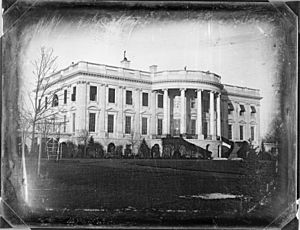
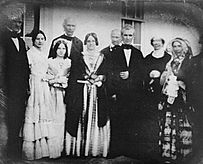
Polk won the popular vote by a small margin, but had a larger victory in the Electoral College (170–105). He quickly began to work on his campaign promises. The U.S. population had doubled every twenty years since the American Revolution. New technologies like railroads and the telegraph were expanding. These improvements encouraged a desire for expansionism. However, divisions between different parts of the country grew worse during his time in office.
Polk set four clear goals for his presidency:
- Bring back the Independent Treasury System. The Whigs had gotten rid of the one created under Van Buren.
- Lower tariffs (taxes on imported goods).
- Gain some or all of the Oregon Country.
- Acquire California and its important harbors from Mexico.
His domestic goals continued past Democratic policies. But his foreign policy goals would be the first major territorial gains for the U.S. since 1819.
Starting the Presidency

Polk chose a Cabinet with members from different parts of the country. He wanted a completely new Cabinet, unlike some presidents who kept their predecessor's team. Polk did not want his Cabinet members to be future presidential candidates. However, he chose James Buchanan of Pennsylvania, who was known to want to be president, as Secretary of State. Cave Johnson of Tennessee became Postmaster General. George Bancroft, the historian who helped Polk get nominated, became Navy Secretary. Polk's choices were approved by Andrew Jackson. Polk met Jackson for the last time in January 1845, as Jackson died that June.
Polk also chose John Y. Mason of Virginia as Attorney General. Robert J. Walker of Mississippi became Secretary of the Treasury. William Marcy of New York became Secretary of War. The Cabinet members worked well together.
In his last days in office, President Tyler tried to complete the annexation of Texas. Polk helped the annexation resolution pass the Senate. On March 3, 1845, Tyler offered annexation to Texas.
Even before his inauguration, Polk wrote, "I intend to be myself President of the U.S." He became known as a hard worker. He spent ten to twelve hours at his desk and rarely left Washington. Polk said, "No President who performs his duty faithfully and conscientiously can have any leisure." When he took office on March 4, 1845, Polk was 49. He was the youngest president at that time. His inauguration was the first to be reported by telegraph.
In his inaugural address, Polk showed his support for Texas annexation. He said the U.S. had 28 states, including Texas. He also supported Jackson's ideas. He was against a national bank and said tariffs could include some protection for American businesses. He also talked about foreign affairs and expansion. He said Texas annexation was not another nation's business. He also spoke about the Oregon Country, promising to protect American rights and settlers there.
Polk also made his nephew, J. Knox Walker, his personal secretary. This was an important job because Polk had no other staff at the White House besides his slaves.
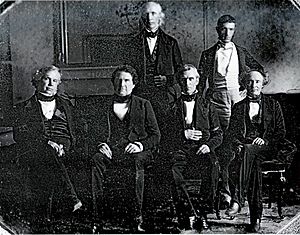
Foreign Policy and Expansion
Dividing the Oregon Country
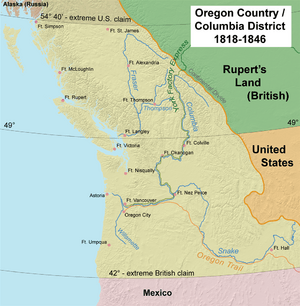
Both Britain and the U.S. claimed the Oregon Country. Instead of fighting, they decided to negotiate. Previous U.S. governments had offered to divide the region at the 49th parallel. Britain did not accept this because they had businesses along the Columbia River. Britain wanted to keep Puget Sound and lands north of the Columbia River.
In 1845, many American settlers moved to the Oregon Country. This, along with the desire for expansion, made a treaty more urgent. Many Democrats believed the U.S. should stretch from coast to coast. This idea was called Manifest Destiny.
In his inaugural address, Polk said the U.S. claim to Oregon was "clear and unquestionable." This made British leaders threaten war. But Polk did not want a war over Oregon. He and Buchanan began talks with the British. Polk again suggested dividing the land at the 49th parallel. The British minister, Richard Pakenham, rejected it.
Secretary of State Buchanan was worried about fighting two wars at once (with Mexico and Britain). But Polk was willing to risk war to get a good deal. In December 1845, Polk asked Congress to approve giving Britain a one-year notice to end their joint control of Oregon. He also used the Monroe Doctrine for the first time in a major way. This doctrine said America would keep European powers out of the continent. Congress approved the notice in April 1846.
The British Foreign Secretary, Lord Aberdeen, wanted to restart talks. Britain was moving towards free trade, so good trade with the U.S. was important. In June 1846, Pakenham offered a deal. The boundary would be at the 49th parallel. Britain would keep all of Vancouver Island. British subjects would have limited navigation rights on the Columbia River. Polk and his Cabinet agreed to this. The Senate approved the Oregon Treaty by a vote of 41–14. Polk's willingness to risk war may have helped the U.S. get better terms.
Annexing Texas
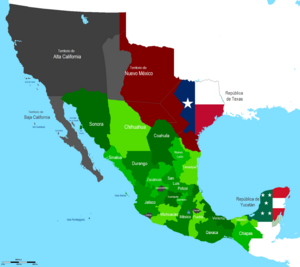
The annexation resolution signed by Tyler gave the president a choice. He could ask Texas to approve annexation, or restart negotiations. Tyler immediately sent a messenger with the first option. Polk let the messenger continue. He also promised that the U.S. would defend Texas. He said the southern border would be the Rio Grande, as Texas claimed. Mexico claimed the border was the Nueces River.
People in Texas wanted annexation. In July 1845, a Texas convention approved it. In December 1845, Texas became the 28th state. However, Mexico had already broken off diplomatic relations with the U.S. in March 1845. Annexation made tensions even worse. Mexico had never recognized Texas's independence.
The Mexican-American War
Leading to War
After Texas was annexed in 1845, Polk started preparing for a possible war. He sent an army to Texas, led by General Zachary Taylor. American land and naval forces were told to respond to any Mexican attacks. But they were also told to avoid starting a war. Polk thought Mexico would give in under pressure.
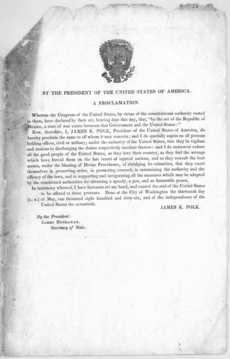
In late 1845, Polk sent John Slidell to Mexico. Slidell was to buy New Mexico and California for $30 million. He also had to get Mexico to agree to the Rio Grande border. Mexican leaders were angry and refused to meet Slidell. Soon, President José Joaquín de Herrera was overthrown by General Mariano Paredes. Paredes was a hard-liner who promised to take back Texas. Slidell's messages warned Washington that war was close.
Polk saw the treatment of Slidell as an insult and a reason for war. He prepared to ask Congress to declare war. In late March, General Taylor reached the Rio Grande. His army camped across the river from Matamoros, Tamaulipas. In April, a Mexican general demanded Taylor return to the Nueces River. Taylor then started blocking Matamoros.
On April 25, a fight happened north of the Rio Grande. Dozens of American soldiers were killed or captured. This became known as the Thornton Affair. News reached Washington on May 9. Polk sent a message to Congress saying Mexico had "shed American blood on the American soil." The House quickly approved a resolution declaring war. It also allowed the president to accept 50,000 volunteers. In the Senate, some people questioned Polk's story. But the resolution passed the Senate 40–2. This marked the start of the Mexican–American War.
The War's Progress
After the first fights, Taylor's army moved away from the river. They left a base called Fort Texas. Mexican forces under General Mariano Arista tried to block Taylor's return. Taylor had to attack to help Fort Texas. In the Battle of Palo Alto, Taylor's troops won. The next day, Taylor won the Battle of Resaca de la Palma. These early victories increased support for the war.
Polk did not trust the two main generals, Winfield Scott and Taylor. Both were Whigs. He wanted to replace them with Democrats, but he knew Congress would not agree. Polk offered Scott the top command. Polk and Scott already disliked each other. Polk thought Scott was too slow. News of Taylor's victory arrived, and Polk decided Taylor should lead in the field. Scott stayed in Washington.
Polk also ordered that Antonio López de Santa Anna be allowed to return to Mexico from exile. Polk thought Santa Anna would negotiate a treaty to sell territory to the U.S. Polk sent people to Cuba to talk with Santa Anna. The blockade was briefly lifted, and Santa Anna returned to Mexico. But instead of negotiating, Santa Anna organized Mexico's defense. Polk had been tricked. Santa Anna's actions made the war last longer.
This made Polk tougher on Mexico. He ordered an American landing at Veracruz, an important Mexican port. From there, troops would march to Mexico City. This was hoped to end the war. Taylor defeated a Mexican army in the Battle of Monterrey in September 1846. But he let the Mexican forces withdraw. Polk was upset, thinking Taylor had not pursued the enemy hard enough. He offered command of the Veracruz expedition to Scott.
The lack of trust was mutual. Taylor, a Whig, feared Polk was trying to ruin his career. Taylor disobeyed orders to stay near Monterrey. In March 1847, Polk learned Taylor had captured Saltillo. Taylor's army then fought a larger Mexican force led by Santa Anna in the Battle of Buena Vista. Taylor won, making him a bigger hero to the American public.
The U.S. changed the war's course by invading Mexico's heartland. In March 1847, Scott landed in Veracruz and quickly took the city. Polk sent Nicholas Trist, a diplomat, to join Scott's army. Trist was to negotiate a peace treaty with Mexican leaders. He was told to get California, New Mexico, and Baja California. He was also to get Mexico to recognize the Rio Grande as the Texas border. Trist could offer up to $30 million.
In August 1847, Scott defeated Santa Anna near Mexico City. With Americans at the city gates, Trist tried to negotiate. But the Mexicans would not give up much. Scott then prepared to take Mexico City, which he did in mid-September. In the U.S., there was a debate about how much Mexican land to take. Some wanted only the Texas border settled. Others wanted to take all of Mexico.
Peace: The Treaty of Guadalupe Hidalgo
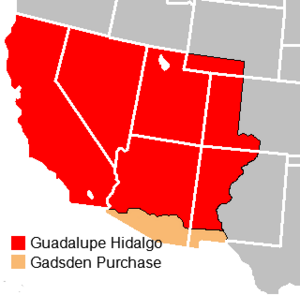
Polk was frustrated by slow negotiations. He ordered Trist to return to Washington. But Trist ignored the order. He decided to stay and negotiate a treaty. Polk was angry but allowed Trist some time.
In January 1848, Trist met with Mexican officials. The treaty was signed in Guadalupe Hidalgo, a town near Mexico City. Trist allowed Mexico to keep Baja California. But he successfully got the important harbor of San Diego included in the land given to the U.S. The treaty also set the Rio Grande border and included a $15 million payment to Mexico.
On February 2, 1848, Trist and the Mexican delegation signed the Treaty of Guadalupe Hidalgo. Polk received the document on February 19. He decided he had to accept it. If he refused, the Whig-controlled House might not fund the war. Some senators opposed the treaty. But on March 10, the Senate approved it 38–14. On June 7, Polk learned that Mexico had also approved the treaty. Polk declared the treaty in effect on July 4, 1848. This ended the war. With California, Polk had achieved all four of his main presidential goals. The land gained under Polk established most of the modern borders of the Contiguous United States.
New Territories and Other Actions
Polk wanted to set up a government for Oregon. But this became part of the arguments over slavery. Bills to create a government for Oregon passed the House twice but failed in the Senate. By December, California and New Mexico were also U.S. lands. Polk asked for governments for all three. The Missouri Compromise had set a line (36°30′ latitude) for slavery in the Louisiana Purchase. Polk wanted to extend this line to the new lands. This would make slavery illegal in Oregon and San Francisco, but allow it in Los Angeles. Northerners in the House blocked this. In 1848, Polk signed a bill to create the Territory of Oregon and ban slavery there.
In December 1848, Polk tried to create governments for California and New Mexico. This was urgent because of the California Gold Rush. The issue of slavery blocked this idea. Finally, the Compromise of 1850 solved the problem after Polk left office.
Polk also signed a bill creating the United States Department of the Interior in March 1849. He worried about the federal government taking too much power over public lands.
Polk's ambassador to the Republic of New Granada (now Colombia), Benjamin Alden Bidlack, negotiated a treaty. The Mallarino–Bidlack Treaty deepened military and trade ties. The U.S. promised to protect New Granada's control over the Isthmus of Panama. This treaty helped build the Panama Canal Railway in 1855. This railway gave a faster, safer way to get to California and Oregon.
In 1848, Polk allowed his ambassador to Spain to negotiate buying Cuba. He offered Spain up to $100 million. Cuba was close to the U.S. and had slavery. This idea appealed to Southerners but not to Northerners. Spain rejected the offer because Cuba was very profitable for them. Polk wanted Cuba, but he did not support private military expeditions to invade the island.
Domestic Policy
Money and Taxes
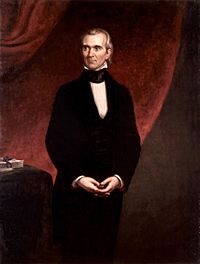
In his first speech as president, Polk asked Congress to bring back the Independent Treasury System. This system meant government money would be kept in the Treasury, not in private banks. President Van Buren had a similar system, but it was ended by the Tyler administration. Polk was against a national bank. In December 1845, he asked Congress to let the government keep its own money. Congress passed the bill in August 1846. Polk signed the Independent Treasury Act into law on August 6, 1846. This system stayed until 1913.
Polk's other main domestic goal was to lower tariffs. He asked Secretary of the Treasury Robert Walker to write a new, lower tariff bill. Polk sent it to Congress. After much debate, the bill passed the House. It passed the Senate by a very close vote, needing Vice President Dallas to break a tie. Polk signed the Walker Tariff into law. This greatly reduced the rates set by the Tariff of 1842. Lower tariffs in the U.S. and Britain led to more trade between the two countries.
Developing the Country
In 1846, Congress passed a bill to spend $500,000 to improve ports. But Polk vetoed it. Polk believed the bill was unconstitutional. He thought it unfairly helped specific areas and ports that did not have foreign trade. Polk felt that improving things inside the country was a job for the states, not the federal government. He feared that such bills would lead to corruption. He followed Andrew Jackson, who had vetoed a similar bill in 1830.
Polk was against federal money for internal improvements. In 1847, Congress passed another such bill. He vetoed it. Similar bills continued in Congress in 1848, but none reached his desk.
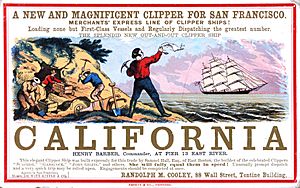
News of gold in California reached Washington after the 1848 election. By then, Polk was leaving office. Polk's opponents had said California was too far away and not worth the price paid to Mexico. The president was very happy about the gold discovery. He saw it as proof that his expansion policy was right. He mentioned the discovery several times in his last message to Congress. Soon after, real gold samples arrived. Polk sent a special message to Congress about it. This message caused many people to move to California, starting the California Gold Rush.
Judicial Appointments
Polk appointed two justices to the U.S. Supreme Court:
| Justice | Position | Began active service |
Ended active service |
| Levi Woodbury | Seat 2 | September 20, 1845 | September 4, 1851 |
| Robert Cooper Grier | Seat 3 | August 4, 1846 | January 31, 1870 |
When Justice Henry Baldwin died in 1844, there was an empty spot on the Supreme Court. President Tyler had not been able to get a nominee approved. It was common to have a judge from each region of the country. Baldwin was from Pennsylvania. Polk's efforts to fill this spot became complicated by Pennsylvania politics.
A second spot opened when Justice Joseph Story died in September 1845. Polk chose Senator Levi Woodbury of New Hampshire for this spot. Woodbury was approved by the Senate. Polk's first choice for Baldwin's seat, George W. Woodward, was rejected by the Senate in January 1846.
Polk later offered the seat to Secretary of State Buchanan, but he turned it down. Polk then nominated Robert Cooper Grier of Pittsburgh, who was approved. Justice Woodbury died in 1851. Grier served until 1870. In the Dred Scott v. Sandford case (1857), Grier wrote that slaves were property and could not sue.
Polk also appointed eight other federal judges.
The 1848 Election
Polk kept his promise to serve only one term. He did not seek re-election. At the 1848 Democratic National Convention, Lewis Cass was nominated. The Whig Party nominated Zachary Taylor for president. Martin Van Buren led a new group called the Free Soil Party. Polk was surprised and disappointed by Van Buren's actions. He worried about a party focused only on ending slavery. Polk did not give speeches for Cass. He stayed at his desk in the White House.
Taylor won the election with 47.3% of the popular vote. Polk was disappointed because he did not think highly of Taylor. However, Polk followed tradition and welcomed President-elect Taylor to Washington. He hosted a dinner for him at the White House. Polk left the White House on March 3, 1849. He attended Taylor's inauguration on March 5. He wished the new president well.
After the Presidency and Death (1849)
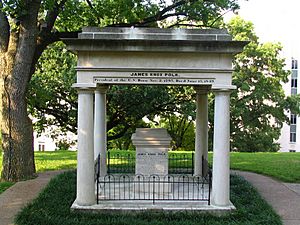
Polk's time as president took a toll on his health. He was full of energy when he started. But he left the presidency exhausted. He left Washington on March 6 for a tour of the Southern United States. The tour was to end in Nashville. Polk had bought a house there, called Polk Place. It had belonged to his mentor, Felix Grundy.
James and Sarah Polk traveled down the Atlantic coast and then west. He was welcomed with enthusiasm. By the time they reached Alabama, he had a bad cold. He became worried about reports of cholera. A passenger on his riverboat died from it. Polk felt so sick that he stayed in a hotel for four days. A doctor told him he did not have cholera. Polk made the final part of the trip. He arrived in Nashville on April 2 to a huge welcome.
After visiting his mother, the Polks settled into Polk Place. The tired former president seemed to get new energy. But in early June, he became sick again, likely with cholera. He was cared for by several doctors. He chose to be baptized into the Methodist Church. On June 15, Polk died at his Polk Place home in Nashville, Tennessee. He was 53 years old. His last words were said to be, "I love you, Sarah, for all eternity, I love you."
Polk's funeral was held at the McKendree Methodist Church in Nashville. After his death, Sarah Polk lived at Polk Place for 42 years. She died on August 14, 1891, at age 87. Their house, Polk Place, was torn down in 1901.
Burials
Polk's remains have been moved twice. After his death, he was buried in what is now Nashville City Cemetery. This was because of a rule for deaths from infectious diseases. Polk was then moved to a tomb at Polk Place in 1850, as he wished in his will.
In 1893, James and Sarah Polk's bodies were moved again. They are now buried on the grounds of the Tennessee State Capitol in Nashville. There have been discussions about moving their remains to the family home in Columbia.
Polk and Slavery
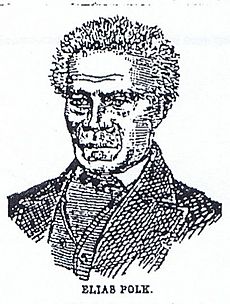
Polk owned slaves for most of his adult life. His father, Samuel Polk, left him over 8,000 acres of land and about 53 enslaved people in 1827. James inherited twenty slaves. In 1831, he became a cotton planter. He sent enslaved people to clear land his father had left him in Tennessee. Four years later, Polk sold that plantation. He bought 920 acres of land, a cotton plantation, near Coffeeville, Mississippi. He hoped to earn more money. The land in Mississippi was richer. Polk moved slaves there, keeping it secret from them that they were going south. From 1839, Polk owned all of the Mississippi plantation. He ran it from a distance for the rest of his life. He visited it sometimes.
Besides inherited slaves, Polk bought more. In 1831, he bought five more slaves. Between 1834 and 1835, he bought five more. In 1839, he bought eight enslaved people from his brother.
The costs of his political campaigns kept Polk from buying more slaves until he was in the White House. He used enslaved people from his home in Tennessee to work at the White House. He bought more slaves with money from his plantation. He wanted to increase his income for retirement. He bought seven slaves in 1846 and nine more in 1847.
Polk's will, written in 1849, said his slaves should be freed after both he and Sarah Polk died. The Mississippi plantation was meant to support Sarah Polk after he died. Sarah Polk lived until 1891. But the slaves were freed in 1865 by the Thirteenth Amendment, which ended slavery in the U.S.
Polk saw slavery as a less important issue compared to expanding the country and economic policy. But the issue of slavery became more and more divisive in the 1840s. Polk's expansion policies made these divisions worse. During his presidency, many people against slavery criticized him. They said he was helping the "Slave Power" and that spreading slavery was why he supported Texas annexation and the war with Mexico. Polk did support expanding slavery. He believed in the rights of Southern states. This meant the right for slave states to not have the federal government interfere with slavery. It also meant Southerners could bring their slaves into new territories. Polk was against the Wilmot Proviso, which would have banned slavery in new lands. But he also criticized Southern leaders who stirred up trouble over slavery. He accused both Northern and Southern leaders of using slavery for political gain.
On March 4, 2017, new tombstones were placed for three of his slaves: Elias Polk, Mary Polk, and Matilda Polk. They are in the Nashville City Cemetery. Elias and Mary Polk lived past slavery. Matilda Polk died in slavery in 1849.
Polk's Legacy and Historical View
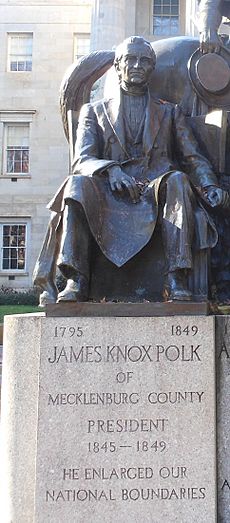
After his death, Polk's historical reputation was first shaped by attacks from his time. Whig politicians said he was not important. Not much was written about him until 1922. That's when Eugene I. McCormac published James K. Polk: A Political Biography. McCormac used Polk's presidential diary, first published in 1909.
When historians started ranking presidents in 1948, Polk was ranked tenth. Later, he was ranked eighth in 1962, 11th in 1996, and 14th in a 2017 survey.
Today, James Polk is often seen as a successful president. He is viewed as a determined leader who worked hard to promote American democracy. Historians say Polk expanded the power of the presidency. Harry S. Truman called Polk "a great president. Said what he intended to do and did it."
Polk is remembered for his success in expanding the country. He created a new map of the United States. This map showed the country stretching across the continent. Historians note that Polk did not consider the impact of this expansion on Mexicans and Native Americans. But his political achievement was impressive. He added vast territory to the United States, including California. This made the U.S. ready to become a world power.
However, historians have criticized Polk for not seeing that his land gains would lead to civil war. He did not understand that slavery and expansion together would create big problems. Some historians suggest that Polk's personal involvement in slavery influenced his views on slavery-related issues.
See also
 In Spanish: James K. Polk para niños
In Spanish: James K. Polk para niños
- List of presidents of the United States
- List of presidents of the United States by previous experience
- Presidents of the United States on U.S. postage stamps


